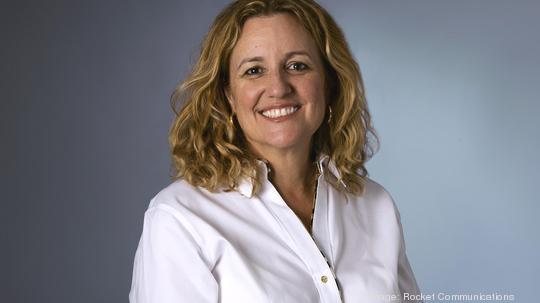
Since launching user experience design firm Rocket Communications in 1992, founder and CEO Michal Anne Rogondino has worked with clients including Intel, Microsoft and the U.S. Space Force.
And for the last 20 years, she’s done it all from the Islands.
While the company’s workforce is primarily remote with employees spread throughout the country, Rogondino and other members of the senior leadership team are based in Hawaii.
“We’ve created and maintained a close-knit team even though we don’t work together in the same building, city or time zone,” she told Pacific Business News.
Rogondino began her career in Silicon Valley at Apple, where she worked on various user experience, or UX, projects. UX design focuses on creating systems to help facilitate consumer usage of digital products, and her projects at Apple included the icons for an early Mac operating system and the control strip first released for the PowerBook in 1994.
But Rogondino said she always aspired to have her own company.
“Because of the work I’d done at Apple, I wanted to continue to design user experiences for large and complex applications. This led to consulting contracts with companies like Oracle, SAP, Quicken, FireEye, Motorola, and more,” she said. “These companies had tremendous technology and droves of engineers, but no designers, so the full potential of their technology wasn’t being accessed by their users.”
The goal of Rocket Communications, Rogondino said, is “making mission critical technology, whether it’s a financial system, medical device or satellite command and communications, more accessible through intuitive, user-centered design.”
Currently, Rogondino said Rocket is working with nine clients — the largest of which is the U.S. Space Force — on 15 projects. The company employs 58 — and is growing. Its revenue increased 50% last year, and it is looking to grow another 50% this year.
What are the latest trends in UX design?
In my opinion, the most significant trend in UX design is that businesses have finally realized the critical importance of having excellent user experiences for their products.
Companies are promoting their user experiences as part of their marketing campaigns because they realize that good UX can be a product differentiator. Companies are investing in not simply hiring designers, but creating enterprise-level design operations to support them.
The other trend has been the close integration design teams have with development teams. Design tools are becoming integrated with development tools, and there’s a choreography happening with designers and developers to quickly create products together as a team.
Design is being treated like an expected part of the product development, not an afterthought brought in to make the app look pretty.
You were recently awarded a $1.7 million contract for a project called Space ACME. Tell me more about this project.
Space ACME was designed to provide an intuitive and visual system for operators to see current satellite system status, orbits and predicted events and then enable them to easily create and visualize multiple potential maneuver options.
Essentially, Space ACME is a system to help avoid accidents in space. We proved Space ACME’s technical feasibility and desirability, so this contract is for incorporating more tools to make the product even stronger.
What has been your strategy in leading your team through the pandemic?
Rocket’s team has been working remotely for more than 20 years, so the pandemic really didn’t impact how we work. That said, we have been conscientious of our team’s mental wellbeing and making sure we validate that it’s okay to not feel okay.
We provided some additional time off during the heat of the pandemic for people to focus on their own and their family’s needs.
We’re also encouraging people to make sure that they and their families are taking care of their mental health in addition to their physical health. Being constantly concerned about getting sick has been stressful for everyone, myself included, so we’re addressing it, not ignoring it.
What advice do you have for businesses when it comes to managing remote teams?
The No. 1 tip for managing remote teams is to hire people who have the capacity to work remotely. … Working from home isn’t for everyone, so make sure you have a team that prefers this arrangement.
It’s easy to get distracted at home and people need to be able to create a mindset that places them in work mode.
That said, it’s also important to have a culture that respects people’s time zones and preferred hours of working. Use tools like Slack and Google Calendar so people can set the times when they’re available and unavailable.
Just because a person isn’t located in an office building doesn’t mean you can skimp on their office supplies and equipment.
Make sure everyone has the best equipment for their home workspace by giving them top-of-the-line computers and funding to buy or upgrade furniture, monitors, lighting, audio/video equipment or whatever it is that they need to professionally do their job.
In addition to giving new employees a set amount to set up their offices when they join Rocket, we also give everyone a monthly allowance to keep their supplies and equipment updated and in good working order.
Our team has become proficient at using online collaboration tools, like Miro and Mural for brainstorming and whiteboard exercises. … But there is still no replacement for in-person collaboration, and we have co-working spaces in Denver, Boise and San Francisco that our teams can use.
Flexibility is desirable, and we try to make it possible for our teams to work in the ways that work best for them. … We’ve flown project teams to work together either on-site with a customer or to one of our offices.
Unfortunately, the pandemic has limited the number of in-person gatherings our team has had the past few years, but things are picking up again. We’re in the process of putting plans in place for a variety of in-person team events.



